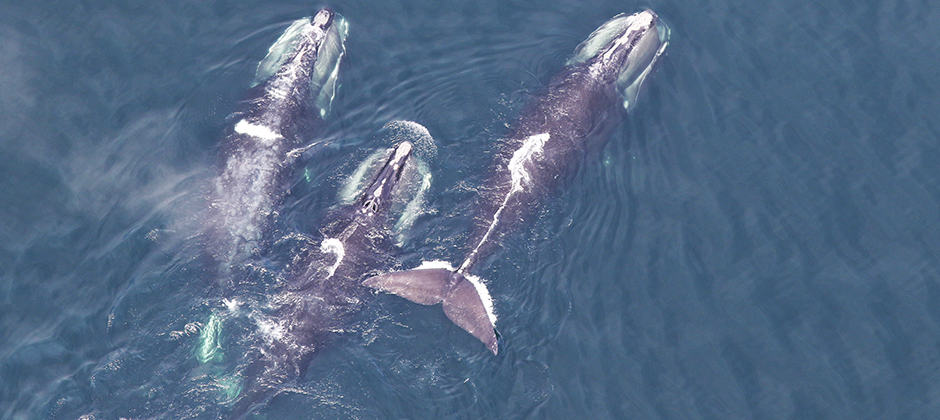Share this article
Climate change brings right whales at the wrong time
Climate change is altering when whales are most active in Cape Cod Bay, an important habitat within the Gulf of Maine. But rather than being active sooner and taking advantage of an early spring, as researchers expected, the migratory whales’ activity is peaking later—a change that has implications for both conservation and industry.
“It’s an anomaly,” said Dan Pendleton, a research scientist at the New England Aquarium’s Anderson Cabot Center for Ocean Life.
Pendleton, the lead author of a study published recently in Global Change Biology, looked at when North Atlantic right whales (Eubalaena glacialis), humpback whales (Megaptera novaeangliae) and fin whales (Balaenoptera physalus) reached their peak activity in Cape Cod Bay, the southernmost edge of the Gulf of Maine.
His team gathered data from aerial surveys the Center for Coastal Studies conducted from 1998 to 2018 to see when the whales were at their peak of activity in Cape Cod Bay. They combined those findings with sea surface temperatures and other data to see when spring was arriving. One of the most rapidly warming regions of the ocean, the Gulf of Maine, has seen sea surface and bottom temperatures ramp up three times faster than the global average.
Because of that, researchers expected the critically endangered right whales, whose migratory range spans from the southeastern U.S. to New England and Canada, would peak sooner in the gulf—a stretch of water between Cape Cod and the tip of Nova Scotia.
“We found the opposite,” Pendleton said. Peak use by right whales and humpback whales was almost three weeks later than it was 20 years ago, with increased use by right whales from February to May.
Pendleton’s team believes the whales are lingering in Cape Cod Bay to fill up on tiny zooplankton that grow there while they wait for richer plankton to develop in the north—places like the Gulf of St. Lawrence, which they are using more and more as the ocean warms.
“The southwestern Gulf of Maine is essentially a waiting room,” Pendleton said, where whales wait for fattier and more calorically dense zooplankton to develop elsewhere. The bay’s zooplankton is “subpar,” he said, but there’s plenty of it.
The study points to the complexity of climate change impacts on wildlife. Warmer temperatures aren’t simply pushing marine species closer to the poles. “There are regional processes driving regional responses to climate change,” Pendleton said.
It also points to the difficulty of crafting regulations to protect migrating species as their timing changes. Only about 336 North Atlantic right whales are known to exist, and their numbers have declined over the past decade due to vessel strikes, fishing gear entanglements and other human activities.
Boating speed limits and fishing restrictions in Cape Cod Bay in the winter and spring are meant to reduce those threats, but the timing of federal restrictions in the U.S. are based on historical patterns, and those patterns are changing. Peak activity, Pendleton found, is coming about a day later each year.
“The whole picture needs to be factored in,” said Robert Schick, a research scientist at Duke’s Nicholas School of the Environment, who wasn’t involved in the research. “It’s certainly complicated because the whales span an international border, but they don’t care about that.”
To better protect the whales throughout their range, regulations need to shift as quickly as the whales change their movements, Pendleton said. Current protections are working, he said, largely because Massachusetts adapts its restrictions based on when aerial surveys show the whales are present. Canada can also change its restrictions quickly, but federal U.S. regulators aren’t as nimble.
“In this habitat, if the protections are in place and the whales are there, then that’s a win-win for the whales, even if it’s changing,” Pendleton said. “But that’s not the case everywhere.”
Header Image:
Three North Atlantic right whales feed at the surface in Cape Cod Bay.
Credit: Brigid McKenna/Center for Coastal Studies under NOAA research permit #19315-01








